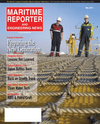
Page 29: of Maritime Reporter Magazine (May 2011)
Training & Education Edition
Read this page in Pdf, Flash or Html5 edition of May 2011 Maritime Reporter Magazine
aforementioned modern bridge and en- gine room simulators, DP simulators,
GMDSS simulators and modern sonar simulators, yet there is really no way to conscientiously differ from the fact that this military mode of training is outdated.
While there is no reason for the Navy to discontinue its training schools, there is no other choice but to allow at least se- lected institutions to open high level civilian maritime training schemes.
According to data presented by Walter
Souza Lima from Offshore Ship Man- agement (OSM), during the 7th Annual
Marine Money - Latin America Ship and
Offshore Finance Forum, held in Sep- tember 2010 in Rio de Janeiro, offshore vessels in Brazil totaled 276 in 2010, of which 135 were foreign flagged (51%) and 132 were Brazilian flagged (48%).
The forecast for 2015 is of 422 offshore vessels with 180 (43%) being foreign flagged and 242 (57%) Brazilian flagged.
In 2010 there was a shortage of 900 offi- cers and by 2013 this shortage is ex- pected to reach 1,419 officers, although with all the new constructions, many be- lieve this expectation has already been reached and surpassed. The demand in 2013 is expected to reach 4,465 maritime officers in total. Some of the conse- quences of these shortages are the prob- able fast promotion of junior officers, crews staying longer aboard, followed by short leave periods, increased accident risks due to on the job training needs, crew cost increases and high OPEX for vessels operating in Brazil. Lima offered suggestions to help to avoid a market col- lapse due to shortage of officers. The main points were the acceptance of for- eign officers as a temporary work force and being more flexible with the NR72* regulation requirements. He also pointed out was the necessity of alternatives to educate Brazilian officers, such as; public and/or private maritime training schools, allowing Brazilian officer candidates to be trained abroad (the Brazilian Navy still does not accept foreign maritime cer- tification from Brazilians) and the neces- sary expansion of both CIAGA and
CIABA training facilities.
May 2011 www.marinelink.com 29
IMSN Earns DNV
Certification for
Anti-Piracy Course
International Maritime Security Net- work (IMSN) became the first maritime security training center to offer an eLearning-based Anti-Piracy Defense
Course certified by Det Norske Veritas (DNV), under its SeaSkill standard for maritime learning programs. The an- nouncement was made by Captain Tim- othy D. Nease (ret.), co-founder and
CEO of IMSN, at the Ship Operations
Cooperative Program (SOCP) in Dania
Beach, Fla. IMSN has the only DNV certified Anti-Piracy Course—offering a blended version of eLearning and practical drills and exercises.
IMSN’s Anti-Piracy Defense Course provides practical training for vital ac- tivities such as watch-keeping, lock- down procedures, anti-piracy drills, hand-to-hand defensive tactics, as well as contingency plans for issues such as surviving a hostage attack or movement of prisoners. The training course also covers concepts related to anti-piracy laws. IMSN’s anti-piracy training course is available online or on DVD. www.imsn.us
Email: [email protected]

 28
28

 30
30
